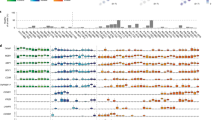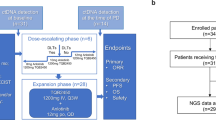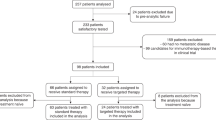Abstract
Background
Systemic therapy for metastatic clear cell sarcoma (CCS) bearing EWSR1-CREB1/ATF1 fusions remains an unmet clinical need in children, adolescents, and young adults.
Methods
To identify key signaling pathway vulnerabilities in CCS, a multi-pronged approach was taken: (i) genomic and transcriptomic landscape analysis, (ii) integrated chemical biology interrogations, (iii) development of CREB1/ATF1 inhibitors, and (iv) antibody-drug conjugate testing (ADC). The first approach encompassed DNA exome and RNA deep sequencing of the largest human CCS cohort yet reported consisting of 47 patient tumor samples and 8 cell lines.
Results
Sequencing revealed recurrent mutations in cell cycle checkpoint, DNA double-strand break repair or DNA mismatch repair genes, with a correspondingly low to intermediate tumor mutational burden. DNA multi-copy gains with corresponding high RNA expression were observed in CCS tumor subsets. CCS cell lines responded to the HER3 ADC patritumab deruxtecan in a dose-dependent manner in vitro, with impaired long term cell viability.
Conclusion
These studies of the genomic, transcriptomic and chemical biology landscape represent a resource ‘atlas’ for the field of CCS investigation and drug development. CHK inhibitors are identified as having potential relevance, CREB1 inhibitors non-dependence of CCS on CREB1 activity was established, and the potential utility of HER3 ADC being used in CCS is found.
This is a preview of subscription content, access via your institution
Access options
Subscribe to this journal
Receive 24 print issues and online access
$259.00 per year
only $10.79 per issue
Buy this article
- Purchase on Springer Link
- Instant access to full article PDF
Prices may be subject to local taxes which are calculated during checkout






Similar content being viewed by others
Data availability
DNA and RNA sequencing data performed for this manuscript is available for access through the EGA repository as Dataset: EGAD00001008611, Study: EGAS00001006072.
References
Green C, Spagnolo DV, Robbins PD, Fermoyle S, Wong DD. Clear cell sarcoma of the gastrointestinal tract and malignant gastrointestinal neuroectodermal tumour: distinct or related entities? A review. Pathology. 2018;50:490–8.
Dim DC, Cooley LD, Miranda RN. Clear cell sarcoma of tendons and aponeuroses: a review. Arch Pathol Lab Med. 2007;131:152–6.
Wang H, Wang L, Zhang G, Lu C, Chu H, Yang R, et al. MALAT1/miR-101-3p/MCL1 axis mediates cisplatin resistance in lung cancer. Oncotarget 2018;9:7501–12.
Kosemehmetoglu K, Folpe AL. Clear cell sarcoma of tendons and aponeuroses, and osteoclast-rich tumour of the gastrointestinal tract with features resembling clear cell sarcoma of soft parts: a review and update. J Clin Pathol. 2010;63:416–23.
Wang WL, Mayordomo E, Zhang W, Hernandez VS, Tuvin D, Garcia L, et al. Detection and characterization of EWSR1/ATF1 and EWSR1/CREB1 chimeric transcripts in clear cell sarcoma (melanoma of soft parts). Mod Pathol. 2009;22:1201–9.
Yokoyama S, Woods SL, Boyle GM, Aoude LG, MacGregor S, Zismann V, et al. A novel recurrent mutation in MITF predisposes to familial and sporadic melanoma. Nature 2011;480:99–103.
Davis IJ, Kim JJ, Ozsolak F, Widlund HR, Rozenblatt-Rosen O, Granter SR, et al. Oncogenic MITF dysregulation in clear cell sarcoma: defining the MiT family of human cancers. Cancer Cell. 2006;9:473–84.
Garraway LA, Widlund HR, Rubin MA, Getz G, Berger AJ, Ramaswamy S, et al. Integrative genomic analyses identify MITF as a lineage survival oncogene amplified in malignant melanoma. Nature 2005;436:117–22.
Panza E, Ozenberger BB, Straessler KM, Barrott JJ, Li L, Wang Y, et al. The clear cell sarcoma functional genomic landscape. J Clin Investig. 2021;131:e146301.
Bayat Mokhtari R, Homayouni TS, Baluch N, Morgatskaya E, Kumar S, Das B, et al. Combination therapy in combating cancer. Oncotarget. 2017;8:38022–43.
Wang J, Thway K. Clear cell sarcoma-like tumor of the gastrointestinal tract: an evolving entity. Arch Pathol Lab Med. 2015;139:407–12.
Segawa K, Sugita S, Aoyama T, Kubo T, Asanuma H, Sugawara T, et al. Detection of specific gene rearrangements by fluorescence in situ hybridization in 16 cases of clear cell sarcoma of soft tissue and 6 cases of clear cell sarcoma-like gastrointestinal tumor. Diagn Pathol. 2018;13:73.
Lee CJ, Modave E, Boeckx B, Stacchiotti S, Rutkowski P, Blay JY, et al. Histopathological and Molecular Profiling of Clear Cell Sarcoma and Correlation with Response to Crizotinib: An Exploratory Study Related to EORTC 90101 “CREATE” Trial. Cancers. 2021;13:6057.
Möller E, Praz V, Rajendran S, Dong R, Cauderay A, Xing YH, et al. EWSR1-ATF1 dependent 3D connectivity regulates oncogenic and differentiation programs in Clear Cell Sarcoma. Nat Commun. 2022;13:2267.
Barlaam B, Anderton J, Ballard P, Bradbury RH, Hennequin LFA, Hickinson DM, et al. Discovery of AZD8931, an Equipotent, Reversible Inhibitor of Signaling by EGFR, HER2, and HER3 Receptors. ACS Med Chem Lett. 2013;4:742–6.
Tse AN, Rendahl KG, Sheikh T, Cheema H, Aardalen K, Embry M, et al. CHIR-124, a novel potent inhibitor of Chk1, potentiates the cytotoxicity of topoisomerase I poisons in vitro and in vivo. Clin Cancer Res. 2007;131:591–602.
Xie F, Li BX, Xiao X. Design, synthesis and biological evaluation of regioisomers of 666-15 as inhibitors of CREB-mediated gene transcription. Bioorg Med Chem Lett. 2017;27:994–8.
Egawa Y, Saigo C, Kito Y, Moriki T, Takeuchi T. Therapeutic potential of CPI-613 for targeting tumorous mitochondrial energy metabolism and inhibiting autophagy in clear cell sarcoma. PLoS ONE. 2018;13:e0198940.
Woods AD, Purohit R, Mitchell LC, Collier JR, Collier KA, Lathara M, et al. Metastatic pediatric sclerosing epithelioid fibrosarcoma. Cold Spring Harb Mol Case Stud. 2021;7:a006093.
Li J, Chen C, Liu W, Liu S, Hu W, Gao X, et al. Whole-exome sequencing in clear cell sarcoma of soft tissue uncovers novel prognostic categorization and drug targets. Clin Transl Med. 2021;11:e640.
Jones RL, Constantinidou A, Thway K, Ashley S, Scurr M, Al-Muderis O, et al. Chemotherapy in clear cell sarcoma. Med Oncol. 2011;28:859–63.
Schöffski P, Wozniak A, Stacchiotti S, Rutkowski P, Blay JY, Lindner LH, et al. Activity and safety of crizotinib in patients with advanced clear-cell sarcoma with MET alterations: European Organization for Research and Treatment of Cancer phase II trial 90101 “CREATE”. Ann Oncol. 2019;30:344.
Wagner AJ, Goldberg JM, Dubois SG, Choy E, Rosen L, Pappo A, et al. Tivantinib (ARQ 197), a selective inhibitor of MET, in patients with microphthalmia transcription factor-associated tumors: results of a multicenter phase 2 trial. Cancer. 2012;118:5894–902.
Schaefer KL, Brachwitz K, Wai DH, Braun Y, Diallo R, Korsching E, et al. Expression profiling of t(12;22) positive clear cell sarcoma of soft tissue cell lines reveals characteristic up-regulation of potential new marker genes including ERBB3. Cancer Res. 2004;64:3395–405.
Beleaua MA, Jung I, Braicu C, Milutin D, Gurzu S SOX11, SOX10 and MITF Gene Interaction: A Possible Diagnostic Tool in Malignant Melanoma. Life. 2021;11:281.
Faloon PW, Bennion M, Weiner WS, Smith RA, Wurst J, Weiwer M, et al. A Small Molecule Inhibitor of the MITF Molecular Pathway. Probe Reports from the NIH Molecular Libraries Program. Bethesda (MD); 2010.
Bresnick AR. S100 proteins as therapeutic targets. Biophys Rev. 2018;10:1617–29.
Jänne PA, Baik C, Su WC, Johnson ML, Hayashi H, Nishio M, et al. Efficacy and Safety of Patritumab Deruxtecan (HER3-DXd) in EGFR Inhibitor-Resistant, EGFR-Mutated Non-Small Cell Lung. Cancer Cancer Discov. 2022;12:74–89.
Langfelder P, Horvath S. WGCNA: an R package for weighted correlation network analysis. BMC Bioinform. 2008;9:559.
Zhang B, Horvath S. A general framework for weighted gene co-expression network analysis. Stat Appl Genet Mol Biol. 2005;4:Article17.
Huang DW, Sherman BT, Lempicki RA. Bioinformatics enrichment tools: paths toward the comprehensive functional analysis of large gene lists. Nucleic Acids Res. 2009;37:1–13.
Benjamini Y, Hochberg Y. Controlling the False Discovery Rate: A Practical and Powerful Approach to Multiple Testing. J R Stat Soc Ser B. 1995;57:289–300.
Song Y, Zhai L, Valencia Swain J, Chen Y, Wang P, Chen L, et al. Structural Insights into the CRTC2-CREB Complex Assembly on CRE. J Mol Biol. 2018;430:1926–39.
Schroedl S. Current methods and challenges for deep learning in drug discovery. Drug Disco Today Technol. 2019;32–33:9–17.
Hiraga H, Nojima T, Abe S, Yamashiro K, Yamawaki S, Kaneda K, et al. Establishment of a new continuous clear cell sarcoma cell line. Morphological and cytogenetic characterization and detection of chimaeric EWS/ATF-1 transcripts. Virchows Arch. 1997;431:45–51.
Liao SK, Perng YP, Lee LA, Chang KS, Lai GM, Wong E, et al. Newly established MST-1 tumour cell line and tumour-infiltrating lymphocyte culture from a patient with soft tissue melanoma (clear cell sarcoma) and their potential applications to patient immunotherapy. Eur J Cancer. 1996;32A:346–56.
Epstein AL, Martin AO, Kempson R. Use of a newly established human cell line (SU-CCS-1) to demonstrate the relationship of clear cell sarcoma to malignant melanoma. Cancer Res. 1984;44:1265–74.
Moritake H, Sugimoto T, Asada Y, Yoshida MA, Maehara Y, Epstein AL, et al. Newly established clear cell sarcoma (malignant melanoma of soft parts) cell line expressing melanoma-associated Melan-A antigen and overexpressing C-MYC oncogene. Cancer Genet Cytogenet. 2002;135:48–56.
Hakozaki M, Tamura H, Dobashi Y, Yoshida A, Kato K, Tajino T, et al. Establishment and Characterization of a Novel Human Clear-cell Sarcoma of Soft-tissue Cell Line, RSAR001, Derived from Pleural Effusion of a Patient with Pleural Dissemination. Anticancer Res. 2018;38:5035–42.
Jishage M, Fujino T, Yamazaki Y, Kuroda H, Nakamura T. Identification of target genes for EWS/ATF-1 chimeric transcription factor. Oncogene 2003;22:41–9.
Nakai T, Imura Y, Tamiya H, Yamada S, Nakai S, Yasuda N, et al. Trabectedin is a promising antitumor agent potentially inducing melanocytic differentiation for clear cell sarcoma. Cancer Med. 2017;6:2121–30.
Schaefer KL, Wai DH, Poremba C, Korsching E, van Valen F, Ozaki T, et al. Characterization of the malignant melanoma of soft-parts cell line GG-62 by expression analysis using DNA microarrays. Virchows Arch. 2002;440:476–84.
Outani H, Tanaka T, Wakamatsu T, Imura Y, Hamada K, Araki N, et al. Establishment of a novel clear cell sarcoma cell line (Hewga-CCS), and investigation of the antitumor effects of pazopanib on Hewga-CCS. BMC Cancer. 2014;14:455.
Takenouchi T, Ito K, Kazama T, Ito M. Establishment and characterization of a clear-cell sarcoma (malignant melanoma of soft parts) cell line. Arch Dermatol Res. 1994;286:254–60.
Sonobe H, Furihata M, Iwata J, Ohtsuki Y, Mizobuchi H, Yamamoto H, et al. Establishment and characterization of a new human clear-cell sarcoma cell-line, HS-MM. J Pathol. 1993;169:317–22.
Sakumoto M, Oyama R, Takahashi M, Takai Y, Kito F, Shiozawa K, et al. Establishment and proteomic characterization of patient-derived clear cell sarcoma xenografts and cell lines. Vitr Cell Dev Biol Anim. 2018;54:163–76.
Crnalic S, Panagopoulos I, Boquist L, Mandahl N, Stenling R, Löfvenberg R. Establishment and characterisation of a human clear cell sarcoma model in nude mice. Int J Cancer. 2002;101:505–11.
Brown AD, Lopez-Terrada D, Denny C, Lee KA. Promoters containing ATF-binding sites are de-regulated in cells that express the EWS/ATF1 oncogene. Oncogene 1995;10:1749–56.
Acknowledgements
We thank Drs. William Tap, Robert Maki, Lia Gore, Carrye Cost, Margaret Macy, and Robin Jones for assistance with therapeutic agent selection for the chemical screen. We are grateful for technical assistance of Kenneth Crawford. We are grateful to Daiichi Sankyo who provided materials for ADC studies. We thank Drs. Miguel Rivera, Emely Möller and Nicolò Riggi for histone track data related to their publication.
Funding
This work was supported by The Sara’s Cure Foundation, Rocker Collier Foundation and Golf Fights Cancer. We thank the Sam Day Foundation for funding for patient sample processing & sequencing through the CuReFast program at cc-TDI.org. DEF gratefully acknowledges support from the Dr. Miriam and Sheldon G. Adelson Medical Research Foundation, and NIH Grants 5R01AR043369–25, 5R01CA222871–04, 5P01CA163222–08, and 5R01AR072304–05.
Author information
Authors and Affiliations
Contributions
NEB, AW, LRB, SVR, PS and CK designed the studies. AW, JL, TK, XX, DEF, EI, IM, ALB, ERR, HM, TN, KT, RLJ, PHH, JW, NG, ILA and PS provided reagents. SVR, LRB, SC, BMS and JMG performed the experiments. SVR, JMG, ML, HW, ADW, KT, NEB, PS, MKS, KN, GS and CK analyzed the data. CK supervised all studies. All authors critically reviewed the report and approved the final version.
Corresponding authors
Ethics declarations
Competing interests
CK has sponsored research agreements with Eli Lily, Roche-Genentech and Cardiff Oncology as well as recent collaborations with Novartis, and is co-founder of Tio Companies. Artisan Biopharma is a wholly-owned subsidiary of cc-TDI. PS has received honoraria from Blueprint Medicines, consults with Deciphera, Ellipses Pharma, Blueprint Medicines,Transgene, Exelixis, Boehringer Ingelheim, Ysios Capital, Studiecentrum voor Kernenergie, Modus Outcomes, Curio Science, SQZ Biotechnology, CRT Pioneer Fund LP, Adcendo, PharmaMar, Merck Healthcare KGaA, Advance Medical/Teladoc Health, and receives research funding from CoBioRes NV, Eisai, G1 Therapeutics, PharmaMar, Genmab, Merck, Sartar Therapeutics, and ONA Therapeutics. DEF has a financial interest in Soltego, a company developing salt inducible kinase inhibitors for topical skin-darkening treatments that might be used for a broad set of human applications. The interests of DEF were reviewed and are managed by Massachusetts General Hospital and Partners HealthCare in accordance with their conflict of interest policies. NEB is founder of First Ascent Biomedical.
Ethics approval
Under institutional review board/human studies ethics committee approvals, de-identified CCS tissue samples were collected from the CuReFast Biobank (Advarra, protocol # cc-TDI-IRB-1), The Royal Marsden Hospital, Universitaire Ziekenhuizen Leuven (University Hospitals Leuven) and the European Organization for Research and Treatment of Cancer (EORTC) 90101 CREATE study [13]. All patients gave written informed consent under approved institutional ethics board protocols (REB# 01–0138-U) and studies were conducted according to the Declaration of Helsinki.
Additional information
Publisher’s note Springer Nature remains neutral with regard to jurisdictional claims in published maps and institutional affiliations.
Supplementary information
Rights and permissions
Springer Nature or its licensor (e.g. a society or other partner) holds exclusive rights to this article under a publishing agreement with the author(s) or other rightsholder(s); author self-archiving of the accepted manuscript version of this article is solely governed by the terms of such publishing agreement and applicable law.
About this article
Cite this article
Rasmussen, S.V., Wozniak, A., Lathara, M. et al. Functional genomics of human clear cell sarcoma: genomic, transcriptomic and chemical biology landscape for clear cell sarcoma. Br J Cancer 128, 1941–1954 (2023). https://doi.org/10.1038/s41416-023-02222-0
Received:
Revised:
Accepted:
Published:
Issue Date:
DOI: https://doi.org/10.1038/s41416-023-02222-0



